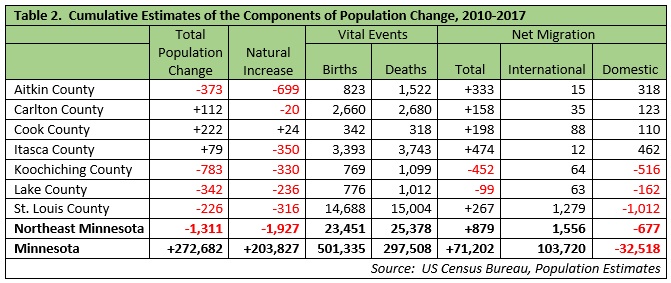 Home to the state's second-largest metro, the Northeast Region has a strong industrial sector, tied largely to the area's abundant natural resources.
Home to the state's second-largest metro, the Northeast Region has a strong industrial sector, tied largely to the area's abundant natural resources.
Most of the manufacturing base centers on mining and forest products industries. More than half of the sector's employment is in paper and machinery manufacturing.
Want the freshest data delivered by email? Subscribe to our regional newsletters.
3/30/2018 12:04:56 PM
Erik White
Recently released data from the Census Bureau shows that population in the Arrowhead region has decreased slightly since 2010. In fact, the 7-county Northeast Minnesota region recorded a loss of 1,311 residents, a 0.4 percent decrease. Compared to the state of Minnesota's 5.1 percent increase in population during that same time period, the Arrowhead region is lagging behind in attracting and retaining residents.
Four of the seven counties in the region have experienced a decrease in population this decade, with Koochiching County seeing a 5.9 percent decrease totaling nearly 800 residents. Other decreases included: Aitkin County with 373 fewer residents, Lake County with 342 fewer residents, and St. Louis County losing 226 residents. On the other hand, Cook County recorded a 4.3 percent increase in population, nearly matching Minnesota's rate of growth. However, due to Cook County's small population, this resulted in an increase of only 222 residents since 2010. Carlton and Itasca counties also recorded small population increases during the timeframe (Table 1).

Looking at the components of population change – which include natural increase and net migration – can provide more details on the region's stationary population trends. One component of population change, natural increase, is simply the number of deaths subtracted from the number of births that occur in a geographic area. In the Arrowhead region, there were nearly 2,000 more deaths than births since 2010. In fact, six of the seven counties in the region had more deaths than births, with the exception of Cook County, resulting in a negative estimate for the natural increase component of population change.
The other component of population change is net migration, including international and domestic migration. Overall, Northeast Minnesota had an increase of 879 residents since 2010 because of net migration. Within the component, international migration resulted in an increase of 1,556 residents to the region while domestic migration led to a loss of 677 residents, as more people moved away from the region than moved in. Interestingly, the state of Minnesota had this same relationship within net migration as there were 103,720 international migrants, but the state lost 32,518 residents due to domestic migration, resulting in an increase of over 71,000 people primarily due to international in-migration since 2010 (Table 2).

While Minnesota has expanded its population since 2010, Northeast Minnesota has not benefited from this influx of new residents. Considering the region's tight labor market, a stagnant population trend could affect future regional economic growth, especially when considering the number of people in the region who are or soon will be retiring out of the workforce. Attraction and retention of people, especially those who are younger, will remain vital if Northeast Minnesota is to increase its population.
Contact Erik White at 218-302-8413.